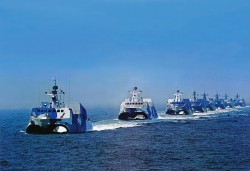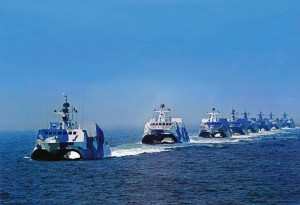A good measure of a military’s intellectual health is it’s dedication to firmly connect present procurement to future purpose. In discussions with peers in the American Navy, I often find myself a lonely voice of pessimism about our future and capabilities. However, LT Albaugh’s article about LCS inadvertently highlights how our procurement vision has managed to stray so far from the path. The U.S. Navy does force-planning through a bureaucratic balancing act of risk aversion rather than making the hard decisions necessary to handle outside threats.
LCS is the perfect example of this inability to commit. When viewed alone, it is a vessel with relatively even capabilities across the board. However, having no relative weakness is not the same as having any strengths. LCS represents an unwillingness to take risks. It is too big to truly be a littoral/riverine boat (PCs would be better). It is too slow to make up for its weak hull and poor weaponry (European corvettes would be better). It is not fast or strong enough to penetrate areas under enemy control, nor advanced enough to perform high-end ISR in those areas(submarines and aircraft would be better). Its real purpose today is clearly as confused as it was 8 years ago. It almost seems like the sole justification for the project really is, as Mr. Albaugh indirectly implies, that it exists. This tepidness is indicative of the Navy’s overall strategic planning. LCS’s attempt to be everything has made it nothing, and is now designed specifically to not risk a weakness for a particular strength.
Compare LCS to the Chinese Houbei-class missile boat. While American defense planners are unable to commit to overly generic systems that are already on the factory floor (F-35), the Chinese navy has committed to a vessel perfectly suited to its area-denial mission. Smaller and of the same hull material and speed of the LCS, the Houbei is weak in many areas by design. However, it is specifically created as part of a particular strategy. With the ability to stealthily approach and then quickly deploy 8 C-803s into an enemy ship, this little mosquito packs a greater ASCM threat than any brawler American ship-of-the-line. When under the aegis of home-turf, the Houbei is an invaluable piece of a very recognizable operational concept. The firm direction of the Chinese investment outclasses by far the strategic waffling behind LCS.
While our competitors learn from and move past their mistakes, we fret over and defend ours. In the past, defense planners forgot that as in the commercial world one can only choose two of the following: cheap, fast, or good. Now, we have forgotten to decide what we actually want before we choose, ending up with: expensive, drawn-out, and poor. There are incredible ideas that the American Navy is capable of executing in the future: unmanned aviation, surface drone motherships, long-range rocket gunnery, REAL patrol boats, SSGNs that create strike opportunities in environments where enemies deny us the surface and air. However, our constant attempts to re-shape ourselves for a single weapon system we “like” or have sunk too much cost into is creating a force-planning disaster; it is becoming less writing on the wall, and more a wall itself.



Very solid commentary. Thanks.
Unfortunately, Google wasn’t around when equivalent programs like the OHP class frigate were started. It would be an interesting comparison point to see if there was as much industry and service churn around that platform compared to LCS today. Did we struggle with similar questions? How long did it really take to make OHP an operational platform bringing value to the fleet? I’m not a big proponent of LCS, but at times, I wonder if we’ve created as much of the anxiety ourselves as opposed to identifying real shortcomings? Just a press-to-test to make sure the ideological blinders weren’t slipped on without our notice…
Another perspective – we’ve fallen into the trap of best being the enemy of good enough. Instead of leveraging a known and proven work like STANFLEX, we succumbed to NIMBY. Instead of putting in a sonar and a towed array tail, we’re counting on a yet unproven ASW module that itself is made up of parts and pieces in varying degrees of maturity. Procurement gaffes – we took delivery of the NLOS missile launcher system even as the Army had declared the program dead. The program has become too big to fail, sadly, but failure could in fact be the best thing to happen, otherwise we’ll just keep iterating this costly and valueless procurement process in the future.
Great comment. One of the first lessons in mircoeconomics we learned was how sunk cost should never factor in to a program’s value. Once the money is gone, it’s gone. If you messed up, spending more money just makes things worse.
As for the OHP, it had a definite mission. It was very capable in its time at doing ASW, which was of critical interest with soviet diesel subs. It also had a potent, if limited, ability to defend itself from surface and air platforms. With it’s high speed, passable weaponry, and a potent ASW suite, it made a great expendable blocker. Granted, they should all be in mothballs now, but they seem like they were a legitimate bet on a real need at the time.
“A good measure of a military’s intellectual health is it’s dedication to firmly connect present procurement to future purpose.”
Perhaps the military is dedicated to firmly connecting present procurement to future purposes, but its the future purposes that are too wide ranging, without any particular strengths. Consider the much touted strategic pivot to the Pacific, which quickly became the pivot to the Pacific and Middle East. We’re re-focusing from the smallest continent, Europe–since the Middle East will see an increase, and Africa and South America will be held steady at nothing–to a theater that covers *only* a third of the globe.
With the array of future purposes towards which likely operations in the Pacific will require as well as those most dangerous operations will require, and the unwillingness to fully mobilize our nation in peacetime to create the Navy needed to meet those needs, it’s not surprising that our acquisition focuses on a small number of “do-everything” ships that do nothing the best.
Bingo, but I think we’re talking about the same thing, an unwillingness to make a bet. However, even a commitment to do everything would look different: Vietnam-style riverine motherships for irregular conflicts in Africa and Pacifica/SE Asia backed up by conventional blue-and-green water capabilities for China/Iran. Choosing LCS due to a strategic “appetite” is the equivalent of bringing no weapon so that no one can accuse you of bringing the wrong weapon. LCS is essentially a single puzzle piece and we are going through the store trying to find the puzzle that will match… rather than the other way around.
https://cimsec.org/mission-first-capabilities-always/